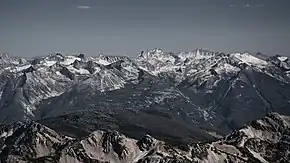| Hall Peak | |
|---|---|
 Southwest aspect | |
| Highest point | |
| Elevation | 3,048 m (10,000 ft)[1][2] |
| Prominence | 829 m (2,720 ft)[2] |
| Parent peak | Mount Findlay (3,162 m)[3] |
| Isolation | 10.94 km (6.80 mi)[2] |
| Listing | Mountains of British Columbia |
| Coordinates | 49°58′24″N 116°35′11″W / 49.97333°N 116.58639°W[4] |
| Naming | |
| Etymology | John H. Hall |
| Geography | |
 Hall Peak Location in British Columbia  Hall Peak Hall Peak (Canada) | |
| Country | Canada |
| Province | British Columbia |
| District | Kootenay Land District |
| Protected area | Purcell Wilderness Conservancy Provincial Park and Protected Area |
| Parent range | Purcell Mountains |
| Topo map | NTS 82F15 Kaslo[4] |
| Geology | |
| Type of rock | Granite[5] |
| Climbing | |
| First ascent | June 1933 |
| Easiest route | class 5 climbing[6] |
Hall Peak is a 3,048-metre (10,000-foot) mountain summit located in British Columbia, Canada.
Description
Hall Peak is situated 24 km (15 mi) east-northeast of Kaslo in the Purcell Mountains and within the Purcell Wilderness Conservancy Provincial Park and Protected Area.[7] Precipitation runoff from the peak's slopes drains to Kootenay Lake via Pinnacle and Fry creeks. Topographic relief is significant as the summit rises approximately 1,400 metres (4,593 ft) in 2 km (1.2 mi). Hall Peak is the highest point of the Leaning Towers Group.[6] The nearest higher neighbor is Mount Clutterbuck, 11.1 km (7 mi) to the northeast.[3]
History
The first ascent of the summit was made in June 1933 by Alexander Addison McCoubrey, Roger Neave, and Burton Blanchard.[8] The group called the peak "Leaning Tower". The mountain is now named in remembrance of Private John H. Hall from Marysville (now part of Kimberley) who was killed in action during World War II.[9] The toponym was officially adopted on May 3, 1961, by the Geographical Names Board of Canada.[4]

Climate
Based on the Köppen climate classification, Hall Peak is located in a subarctic climate zone of western North America.[10] Winter temperatures can drop below −20 °C with wind chill factors below −30 °C. This climate supports a small unnamed glacier on the north aspect of the peak. The months June through September offer the most favorable weather for climbing this peak.
See also
References
- ↑ BC Basemap topographic map
- 1 2 3 "Hall Peak, British Columbia". Peakbagger.com. Retrieved 2023-03-26.
- 1 2 "Hall Peak, Peakvisor.com". Retrieved 2023-03-26.
- 1 2 3 "Hall Peak". Geographical Names Data Base. Natural Resources Canada. Retrieved 2023-03-26.
- ↑ Chic Scott (2000), Pushing the Limits: The Story of Canadian Mountaineering, Rocky Mountain Books, ISBN 9780921102595, p. 149
- 1 2 Hall Peak Rock Climbing, Mountainproject.com, Retrieved March 26, 2023.
- ↑ "Hall Peak". BC Geographical Names.
- ↑ Robert Kruszyna, William Lowell Putnam (III) (1977), A Climber's Guide to the Interior Ranges of British Columbia, south, American Alpine Club, p. 175.
- ↑ Glen W. Boles, William Lowell Putnam, Roger W. Laurilla (2006), "Canadian Mountain Place Names", Rocky Mountain Books, ISBN 9781894765794, p. 116.
- ↑ Peel, M. C.; Finlayson, B. L.; McMahon, T. A. (2007). "Updated world map of the Köppen−Geiger climate classification". Hydrol. Earth Syst. Sci. 11. ISSN 1027-5606.
External links
- Hall Peak (photo): PBase
- Hall Peak (photo): PBase
- 1933 photo of Leaning Tower (Hall Peak) by A.A. McCoubrey: Mountainproject.com
- Hall Peak rock climbing: Mountainproject.com
- Weather: Hall Peak